Contact Center Analytics Tips for Better Customer Insights

Understanding your customers is the key to delivering exceptional service. Contact centre customer analytics empowers you to uncover patterns, preferences, and pain points in customer interactions. This data helps you make informed decisions that improve satisfaction and loyalty. By adopting analytics best practices, you can stay ahead in the competitive landscape. Tools like Sobot's solutions enable you to efficiently track and analyze customer insights, ensuring your strategies align with evolving expectations.
Understanding Contact Center Customer Analytics
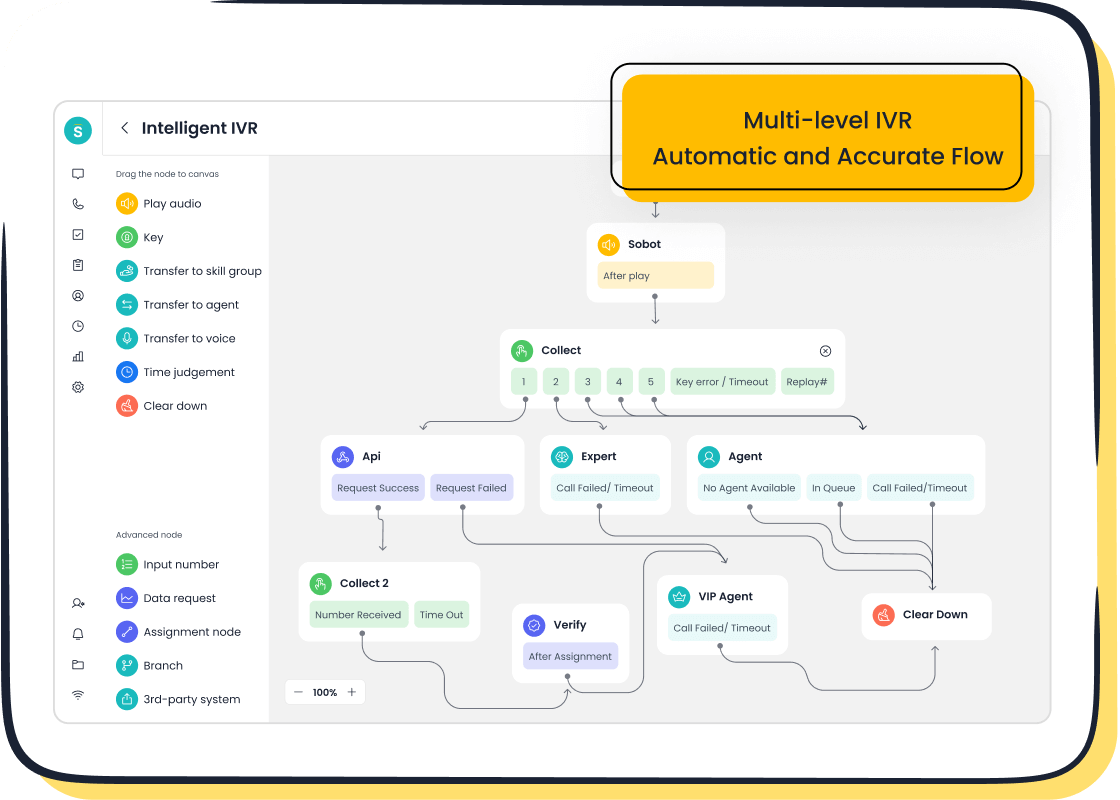
What Is Contact Center Analytics?
Contact center analytics refers to the process of collecting, analyzing, and interpreting data from customer interactions within a contact center. It helps you uncover valuable insights about customer behavior, preferences, and challenges. By leveraging this data, you can make informed decisions to improve the overall customer experience.
At its core, contact center analytics relies on three foundational aspects:
| Aspect | Description |
|---|---|
| Data Processing Infrastructure | Ensures accurate data collection and management for actionable insights. |
| Model Selection Criteria | Helps you choose the right tools, such as API integrations or self-hosted solutions, based on your needs. |
| Integration with Existing Systems | Enables seamless connectivity with CRM, workforce management, and quality monitoring tools. |
These elements form the backbone of effective analytics, ensuring you can extract meaningful insights from your contact center operations.
Key Components of Contact Center Analytics
To maximize the potential of contact center analytics, you need to focus on critical metrics that directly impact performance and customer satisfaction. Some of the most important metrics include:
| Metric | Description |
|---|---|
| Call abandonment rate | Tracks the percentage of callers who hang up before reaching an agent. Aim to keep this below 5%. |
| First call resolution (FCR) | Measures the percentage of issues resolved during the first interaction. High FCR boosts satisfaction. |
| Average handle time (AHT) | Indicates the total time spent on a call, balancing efficiency with service quality. |
| Service level | Monitors the percentage of calls answered within a specific timeframe, often targeting 80% in 20 seconds. |
By tracking these metrics, you can identify areas for improvement and ensure your contact center operates efficiently.
The Role of Analytics in Enhancing Customer Experience
Analytics plays a pivotal role in transforming the customer experience. Businesses that effectively use data analytics are 23 times more likely to acquire customers, 6 times more likely to retain them, and 19 times more likely to achieve profitability. This demonstrates the power of data-driven strategies in driving success.
AI-powered analytics allows you to analyze large datasets, uncover patterns, and understand the true impact of your services. For example, root cause analysis (RCA) helps you identify the underlying reasons for repeated customer contacts. By addressing these root causes, you can enhance satisfaction and reduce frustration. Additionally, machine learning enables you to predict customer needs, allowing you to deliver proactive and personalized solutions.
Benefits of Contact Center Analytics for Businesses
Improved Customer Satisfaction and Loyalty
Contact center analytics helps you understand your customers better, enabling you to deliver personalized experiences. By analyzing customer behavior, you can tailor rewards and incentives to individual preferences. For example:
- Sending targeted communications based on customer data.
- Designing loyalty programs that align with customer needs.
In the retail sector, analytics improves customer segmentation, leading to higher repeat purchases and increased transaction values. Similarly, in hospitality, predictive service recommendations enhance satisfaction. These insights allow you to build stronger relationships with your customers, fostering loyalty and trust.
| Sector | Improvement Metrics |
|---|---|
| Retail Sector | Increase in repeat purchases, higher average transaction value, enhanced customer segmentation |
| Hospitality and Service | Personalized experience design, predictive service recommendations, measurable enhancement of overall customer satisfaction |
Enhanced Operational Efficiency
Analytics optimizes your contact center operations by identifying inefficiencies and improving resource allocation. For instance, tracking performance metrics like call abandonment rate and average speed of answer ensures better service delivery. Predictive analytics also helps you anticipate peak hour traffic, allowing you to staff appropriately and reduce wait times.
| Metric | Description |
|---|---|
| Call Abandonment Rate | Measures the percentage of calls that disconnect before being answered, indicating customer dissatisfaction. |
| Average Speed of Answer | Reflects the average time taken for a live agent to answer a call, impacting customer satisfaction. |
| Cost Per Call | Indicates the average cost to handle each phone call, providing insight into cost-effectiveness. |
| Peak Hour Traffic Analysis | Helps optimize staffing during high call volumes to enhance customer satisfaction. |
Organizations using advanced analytics report a 15-20% improvement in efficiency and a 10% reduction in operational costs. These gains translate into better service quality and lower operational expenses.
Data-Driven Decision-Making
Data-driven decision-making empowers you to make informed choices that improve your contact center's performance. By leveraging analytics, you can identify trends, predict customer needs, and optimize processes. For example, LiveVox processes over 14 billion interactions annually, using analytics to enhance customer engagement. Their partnership with GoodData enabled the creation of detailed dashboards for performance optimization.
This approach allows you to focus on actionable insights rather than guesswork. With tools like call center reporting, you can monitor contact center metrics in real-time, ensuring your strategies align with business goals. Companies using customer analytics are 23 times more likely to outperform competitors in customer acquisition and 19 times more likely to achieve above-average profitability.
Proactive Problem-Solving with Predictive Analytics
Predictive analytics empowers you to address potential issues before they escalate, transforming your contact center into a proactive problem-solving hub. By analyzing historical data and identifying patterns, you can anticipate customer needs and streamline operations for better outcomes.
One of the key benefits of predictive analytics is its ability to uncover trends in customer interactions. This insight allows you to resolve issues before they impact the customer experience. For example, if data shows a recurring issue with a product or service, you can address it proactively by notifying customers or providing solutions in advance. This approach not only reduces frustration but also builds trust and loyalty.
Predictive analytics also enhances team communication. By consolidating insights in real-time, it ensures that everyone has access to the same data. This fosters collaboration and enables faster decision-making. Additionally, it improves resource allocation by forecasting peak call volumes, helping you staff your contact center more effectively.
Here are some practical applications of predictive analytics in contact centers:
| Use Case | Description |
|---|---|
| Anticipating Customer Needs | Forecasts preferences and behaviors, enabling proactive engagement. |
| Operational Efficiency | Analyzes historical data to optimize processes and allocate resources. |
| Customer Satisfaction | Provides personalized support, enhancing the overall customer experience. |
By leveraging predictive analytics, you can transform your contact center into a strategic asset. It equips you with the tools to predict challenges, improve efficiency, and deliver exceptional service. This data-driven approach ensures that your contact center stays ahead of customer expectations, fostering long-term success.
Contact Center Best Practices for Implementing Analytics

Identify and Track Key Metrics
Tracking the right metrics is essential for improving your contact center’s performance. Metrics provide a clear picture of how well your operations align with customer expectations. Start by defining measurable goals for your analytics strategy. For example, focus on metrics like First Call Resolution (FCR), Average Handling Time (AHT), and Customer Satisfaction (CSAT). These indicators help you evaluate agent efficiency, service quality, and customer loyalty.
| KPI | Description |
|---|---|
| First Call Resolution (FCR) | Measures the percentage of customer inquiries resolved during the first contact, indicating agent effectiveness and customer satisfaction. |
| Average Handling Time (AHT) | Assesses the average time spent on customer interactions, balancing efficiency and service quality. |
| Service Level | Tracks the percentage of calls answered within a specific timeframe, ensuring prompt customer service. |
| Abandonment Rate | Gauges the percentage of customers who hang up before speaking to an agent, reflecting service quality and customer frustration. |
| Customer Satisfaction (CSAT) | Indicates how satisfied customers are with the service, typically gathered through post-interaction surveys. |
Regularly reviewing these metrics ensures your analytics strategy remains effective. For example, monitoring abandonment rates can help you identify bottlenecks in call handling. Tools like Sobot’s Voice/Call Center simplify this process by offering real-time data tracking and analysis.
Leverage Advanced Tools Like Sobot’s Voice/Call Center
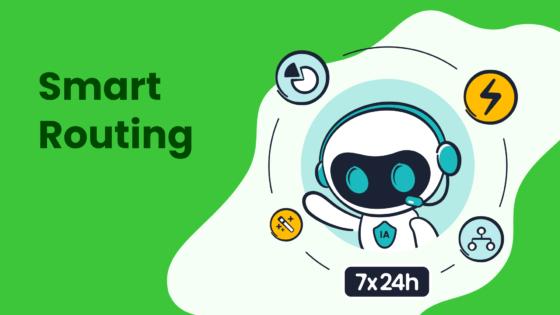
Advanced tools play a crucial role in implementing contact center best practices. Sobot’s Voice/Call Center provides features like intelligent IVR, smart call routing, and AI-powered Voicebot. These tools enhance your ability to collect and analyze data, enabling you to uncover actionable insights.
For example, the platform’s real-time monitoring feature allows you to track call quality and agent performance instantly. Its seamless integration with CRM systems ensures you have a unified view of customer interactions. Additionally, the AI-powered Voicebot improves customer engagement by recognizing intent and delivering personalized responses.
| Tool Name | Key Features |
|---|---|
| CallMiner Eureka | Captures and analyzes customer interactions, providing insights into customer attitudes through sentiment analysis. |
| Talkdesk Interaction | Offers real-time insights into customer interactions, identifying key conversational moments and sentiments. |
| NICE CXone | Features advanced speech analytics, including sentiment analysis and trend detection for real-time insights. |
| Observe.AI | Provides actionable feedback through built-in coaching and evaluation workflows. |
| Sobot Voice/Call Center | Offers intelligent IVR, smart call routing, AI-powered Voicebot, and real-time monitoring for enhanced analytics. |
By leveraging tools like Sobot’s Voice/Call Center, you can streamline operations and improve decision-making. These solutions empower you to implement contact center best practices effectively, ensuring better customer insights and satisfaction.
Train Staff to Use Analytics Effectively
Your analytics tools are only as effective as the people using them. Training your staff ensures they can interpret data accurately and apply insights to improve customer interactions. Begin by defining clear training objectives. Focus on teaching employees how to use analytics platforms and understand key metrics.
Tip: Invest in platforms that automate data collection and provide real-time feedback. This simplifies the learning process and boosts staff proficiency.
Use multiple evaluation methods to measure training effectiveness. For example, assess knowledge retention and time-to-proficiency. Encourage employees to apply their training to real-world scenarios, such as analyzing call data to identify trends.
- Key training evaluation methods include:
- Time-to-proficiency: Measures how quickly employees become proficient after training.
- Knowledge retention: Assesses how much information employees retain over time.
- Training-to-task mastery transfer: Evaluates the application of skills gained in training to job tasks.
Sobot’s Voice/Call Center supports training initiatives by offering intuitive dashboards and analytics tools. These features simplify data interpretation, helping your team make informed decisions. With proper training, your staff can maximize the benefits of contact center analytics, driving better results for your business.
Ensure Seamless Data Integration Across Systems
Seamless data integration is essential for effective contact center analytics. When your systems work together, you gain a unified view of customer interactions. This allows you to make better decisions and improve the overall customer experience. Without proper integration, data silos can form, leading to incomplete insights and inefficiencies.
To ensure smooth data integration, follow these steps:
-
Evaluate Your Current Systems
Identify all the tools and platforms your contact center uses, such as CRM software, workforce management systems, and quality monitoring tools. Check if these systems can share data with each other. -
Choose Compatible Solutions
Select tools that support integration. For example, Sobot’s omnichannel solutions connect seamlessly with CRM systems, enabling you to unify customer interactions across channels like voice, email, and social media. -
Use APIs for Connectivity
Application Programming Interfaces (APIs) allow different systems to communicate. APIs simplify the process of linking your contact center tools, ensuring that customer data flows smoothly between platforms. -
Centralize Customer Data
Store all customer information in a single database. This approach ensures that agents can access complete customer histories, improving service quality and reducing repetitive questions. -
Test and Monitor Integration
After integrating your systems, test them to ensure they work as expected. Regularly monitor the data flow to identify and fix any issues quickly.
Tip: Integrated systems not only improve efficiency but also enhance customer satisfaction. With a unified view of customer data, your agents can provide faster and more personalized support.
By integrating your systems, you can unlock the full potential of customer data analytics. This step is crucial for creating a seamless omnichannel experience, where customers receive consistent service across all touchpoints.
Regularly Review and Refine Analytics Strategies
Analytics strategies need regular updates to stay effective. Customer behavior and business goals change over time, so your approach to analytics must adapt. Reviewing and refining your strategies ensures that your contact center remains competitive and customer-focused.
Here’s how you can keep your analytics strategies up to date:
-
Set Clear Goals
Define what you want to achieve with your analytics. For example, you might aim to reduce average handling time or improve first call resolution rates. Clear goals help you measure success and identify areas for improvement. -
Analyze Performance Metrics
Regularly review key performance indicators (KPIs) like customer satisfaction scores and call abandonment rates. Use these insights to adjust your strategies. For instance, if your abandonment rate is high, consider optimizing staffing during peak hours. -
Incorporate Feedback
Gather feedback from agents and customers. Agents can provide insights into operational challenges, while customers can highlight pain points in their experience. Use this feedback to refine your analytics approach. -
Leverage Advanced Tools
Tools like Sobot’s Voice/Call Center offer real-time monitoring and AI-powered analytics. These features help you identify trends and make data-driven decisions. For example, predictive analytics can forecast customer needs, enabling proactive engagement. -
Stay Updated on Trends
Keep an eye on industry trends and emerging technologies. Adopting innovations like AI and machine learning can enhance your analytics capabilities and give you a competitive edge.
Note: Refining your analytics strategies is an ongoing process. Regular updates ensure that your contact center adapts to changing customer expectations and market conditions.
By reviewing and refining your strategies, you can maximize the value of customer data analytics. This approach helps you stay ahead in delivering exceptional service and maintaining a strong omnichannel presence.
Overcoming Challenges in Call Center Analytics Implementation
Addressing Data Silos and Integration Issues
Data silos often hinder the effectiveness of call center analytics by creating fragmented insights. When customer data resides in separate systems, it becomes challenging to gain a unified view of operations. This lack of integration can lead to inefficiencies and missed opportunities to improve customer experiences.
To overcome this challenge, you need to focus on integrating omnichannel data sources. Consolidating data from all customer interaction points, such as voice, email, and social media, provides a complete view of the customer journey. This approach enhances decision-making by offering accurate and actionable insights.
Key strategies to address data silos include:
- Implementing integration solutions that unify operations and improve efficiency.
- Using APIs to connect disparate systems, ensuring seamless data flow.
- Centralizing customer data in a single database for shared access.
For example, integration solutions not only enhance operational efficiency but also improve agent performance. By providing a comprehensive view of customer interactions, these solutions help agents better understand customer expectations and pain points. Advanced analytics tools further transform raw data into meaningful insights, enabling proactive engagement and better service delivery.
| Challenge | Solution |
|---|---|
| Defining KPIs | Establish KPIs that align with organizational goals to ensure analytics efforts are focused. |
| Integrating omnichannel data | Consolidate data from all customer interaction points for a complete view of the customer journey. |
| Utilizing advanced tools | Implement predictive analytics platforms to enhance data interpretation and decision-making. |
| Adapting to changing demands | Invest in a future-ready analytics framework to ensure adaptability and success in a competitive environment. |
By addressing data silos, you can unlock the full potential of call center analytics and create a seamless customer experience.
Building Analytics Expertise Within Teams
Your team’s ability to interpret and act on data is critical for the success of call center analytics. Without in-house expertise, even the most advanced tools may fail to deliver meaningful results. Building analytics expertise ensures your team can drive business changes based on data insights.
Start by establishing a dedicated analytics team. This team should focus on interpreting data, recommending actions, and implementing improvements. Providing specialized training enhances employees’ data skills, enabling them to use analytics tools effectively. For example, prescriptive analytics can guide your team by recommending specific actions based on insights.
Steps to build analytics expertise:
- Create infrastructure to act on analytics recommendations.
- Set up effective reporting systems to share insights across the organization.
- Centralize company-wide data for easy access and collaboration.
- Offer continuous training to improve employees’ data interpretation skills.
Strong communication between the analytics team and other departments is essential. Regular updates and feedback loops ensure everyone stays aligned with organizational goals. Agile mechanisms for continuous improvement also help your team adapt to changing demands.
By investing in in-house analytics expertise, you empower your team to maximize the value of call center analytics. This approach drives better decision-making and improves overall performance.
Managing Resistance to Change Among Staff
Introducing analytics-driven changes in your contact center may face resistance from staff. Employees often fear new technologies or processes, worrying about their ability to adapt. Addressing this resistance is crucial for the successful implementation of call center analytics.
Effective change management practices can significantly reduce resistance. Transparent communication plays a key role. When you explain the benefits of analytics and involve employees in the process, they feel more engaged and less apprehensive. Leadership commitment also fosters trust and encourages acceptance.
Study Insight: Comprehensive communication and leadership commitment reduce resistance and foster acceptance during organizational change.
Strategies to manage resistance:
- Engage in two-way dialogue with employees to foster ownership and commitment.
- Align the change initiative with your organization’s culture and values.
- Provide support and training to enhance employee confidence and capability.
- Stay flexible and adjust strategies based on ongoing feedback.
Recognizing early signs of resistance, such as decreased morale, allows you to address concerns proactively. For example, if employees express doubts about using analytics tools, offer hands-on training sessions to build their confidence. Highlighting success stories within the organization can also motivate staff to embrace change.
By managing resistance effectively, you create a supportive environment for analytics-driven transformation. This ensures your team fully leverages the power of call center analytics to improve customer experiences and operational efficiency.
Ensuring Data Privacy and Compliance
Data privacy and compliance are critical for building trust with your customers. In today’s digital landscape, customers expect businesses to safeguard their personal information. Failing to meet these expectations can damage your reputation and lead to significant financial penalties. By prioritizing data protection, you not only comply with regulations but also enhance customer loyalty.
Why Data Privacy Matters
Customers value their privacy more than ever. Studies show that 86% of Americans feel increasingly concerned about how their data is handled. Additionally, 94% of organizations report that customers would stop buying from them if they failed to protect data properly. These statistics highlight the direct link between data privacy and customer trust.
| Statistic | Source |
|---|---|
| 94% of organizations say their customers would not buy from them if they did not protect data properly. | Cisco |
| 86% of the US general population say data privacy is a growing concern for them. | KPMG |
| 72% of Americans believe there should be more government regulation on what can be done with personal data. | Pew Research Center |
| 73% of organizational leaders agreed that cyber and privacy regulations effectively reduce cyber risks. | Zluri |
| 84% of security and IT professionals state that adherence to data protection frameworks such as GDPR and CCPA is mandatory for their industries. | Zluri |
| 95% of organizations say the benefits of investing in data privacy exceed costs. | Cisco |
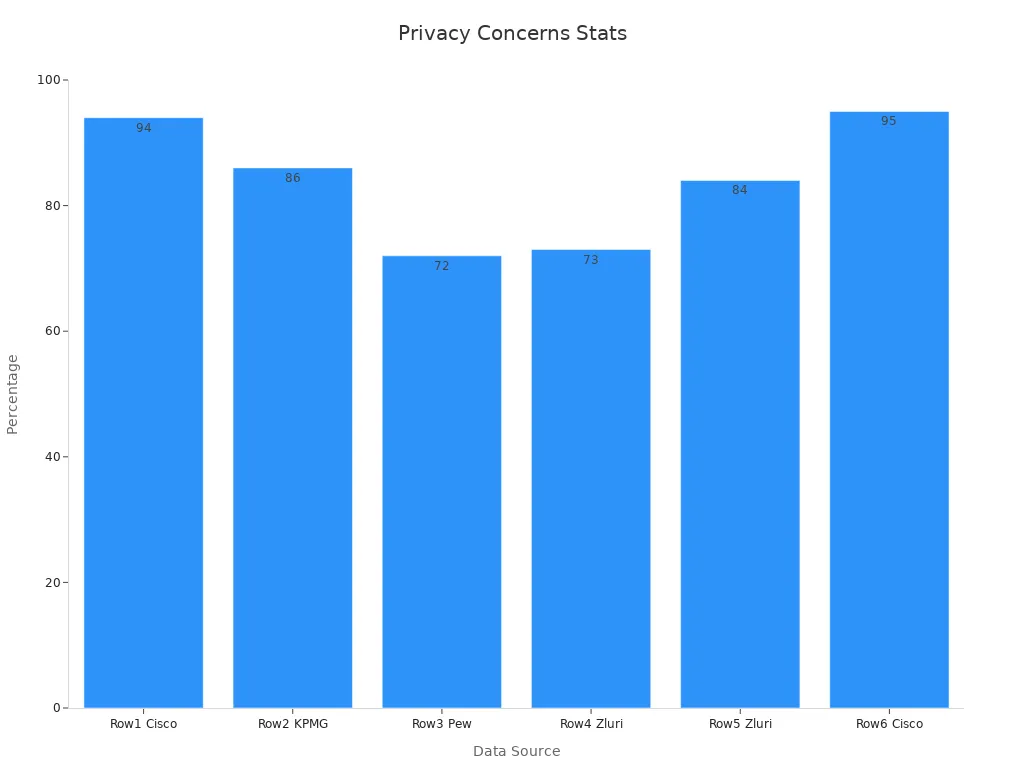
Key Regulations to Follow
Adhering to data protection laws is essential for maintaining compliance. Frameworks like the General Data Protection Regulation (GDPR) and the California Consumer Privacy Act (CCPA) set clear guidelines for handling customer data. These regulations require you to:
- Obtain explicit consent before collecting personal information.
- Provide customers with access to their data upon request.
- Ensure secure storage and transfer of sensitive information.
- Notify authorities and affected individuals in case of a data breach.
Failing to comply with these laws can result in hefty fines. For example, GDPR violations can cost up to €20 million or 4% of annual global turnover, whichever is higher. Staying compliant not only avoids penalties but also demonstrates your commitment to ethical business practices.
Best Practices for Ensuring Data Privacy
To protect customer data effectively, you need a proactive approach. Here are some best practices to implement in your contact center:
-
Conduct Regular Audits
Review your data handling processes to identify vulnerabilities. Regular audits help you stay compliant and address potential risks before they escalate. -
Train Your Team
Educate your staff on data privacy regulations and best practices. Ensure they understand the importance of safeguarding customer information during every interaction. -
Use Secure Technology
Invest in tools that prioritize data security. For instance, Sobot’s Voice/Call Center ensures encrypted data transfer and complies with global privacy standards. -
Limit Data Access
Restrict access to sensitive information based on roles. This minimizes the risk of unauthorized access and data breaches. -
Monitor and Respond to Threats
Implement real-time monitoring systems to detect suspicious activities. Quick responses to potential threats can prevent data breaches and protect customer trust.
Tip: Partnering with a trusted provider like Sobot ensures your contact center meets the highest security standards. Their solutions offer advanced encryption and seamless compliance with GDPR, CCPA, and other frameworks.
By following these practices, you can create a secure environment for customer interactions. This not only protects your business from legal risks but also strengthens your relationship with customers.
The Business Case for Data Privacy
Investing in data privacy delivers measurable benefits. According to Cisco, 95% of organizations find that the advantages of data protection outweigh the costs. These benefits include:
- Increased Customer Trust: Customers are more likely to engage with businesses that prioritize their privacy.
- Operational Efficiency: Compliance frameworks streamline data management processes, reducing inefficiencies.
- Competitive Advantage: Demonstrating a commitment to privacy sets you apart in a crowded market.
By making data privacy a priority, you position your contact center as a trusted partner in customer interactions. This approach not only ensures compliance but also drives long-term success.
How Sobot’s Voice/Call Center Enhances Contact Center Analytics
Intelligent IVR and Smart Call Routing
Sobot’s Voice/Call Center uses intelligent IVR and smart call routing to streamline customer interactions. These features connect callers with the right agents quickly, reducing frustration and improving first call resolution rates. By automating workflows, the system minimizes idle time for agents and speeds up call connections, boosting productivity.
Key metrics highlight the impact of these tools:
| Metric | Description |
|---|---|
| First contact resolution (FCR) | Measures the percentage of calls resolved on the first interaction. |
| Call wait time | Tracks the average time customers wait before their call is answered. |
| Call abandonment | Indicates the rate at which customers hang up before being connected. |
| IVR transitions | Evaluates how smoothly customers navigate through the IVR system. |
These features also provide valuable data on call patterns and agent performance, enabling better decision-making. For example, Sobot’s IVR system improves operational efficiency by reducing call handle times and enhancing customer satisfaction.
Tip: Intelligent IVR systems not only improve service quality but also reduce costs by optimizing resource allocation.
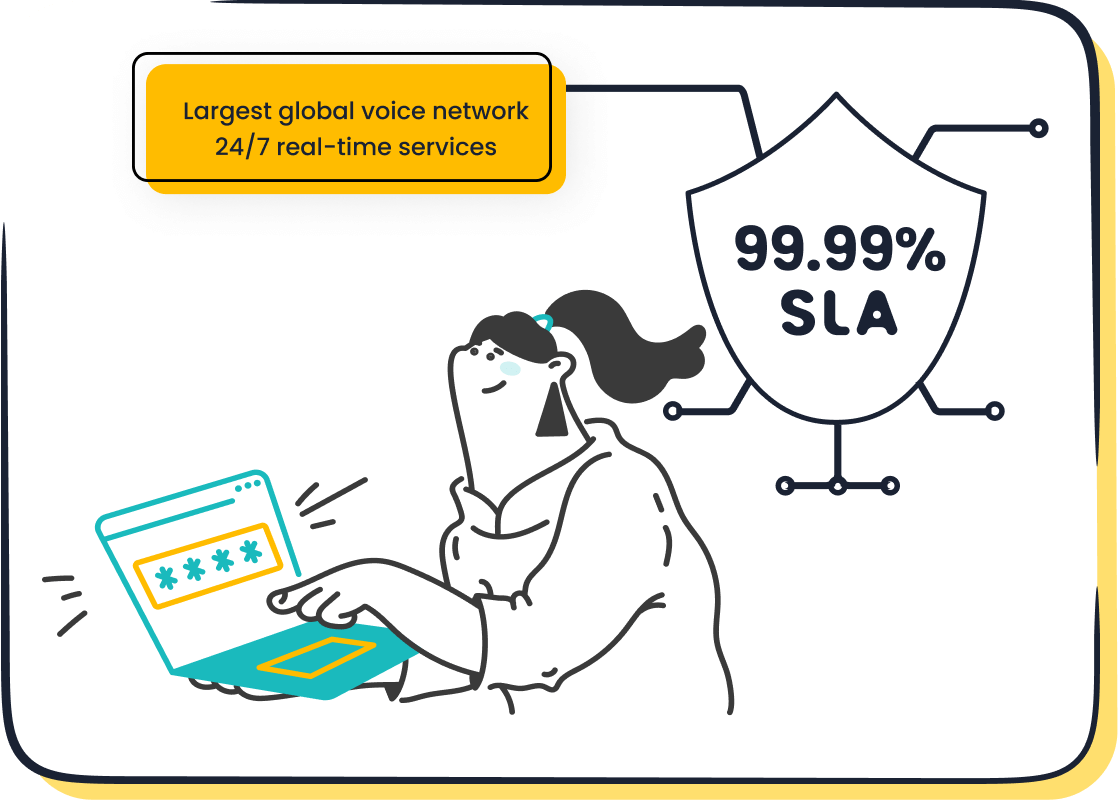
Real-Time Monitoring and Data Analysis
Sobot’s Voice/Call Center offers real-time monitoring and analytics, giving you instant insights into call data and agent performance. This capability allows you to identify inefficiencies and make adjustments on the spot. For example, transportation logistics companies use real-time analytics to enhance visibility along freight lines, while telecommunications firms optimize network performance and detect fraud.
Real-time monitoring also supports predictive maintenance by analyzing equipment data to anticipate failures. In contact centers, this translates to proactive problem-solving and improved customer experiences.
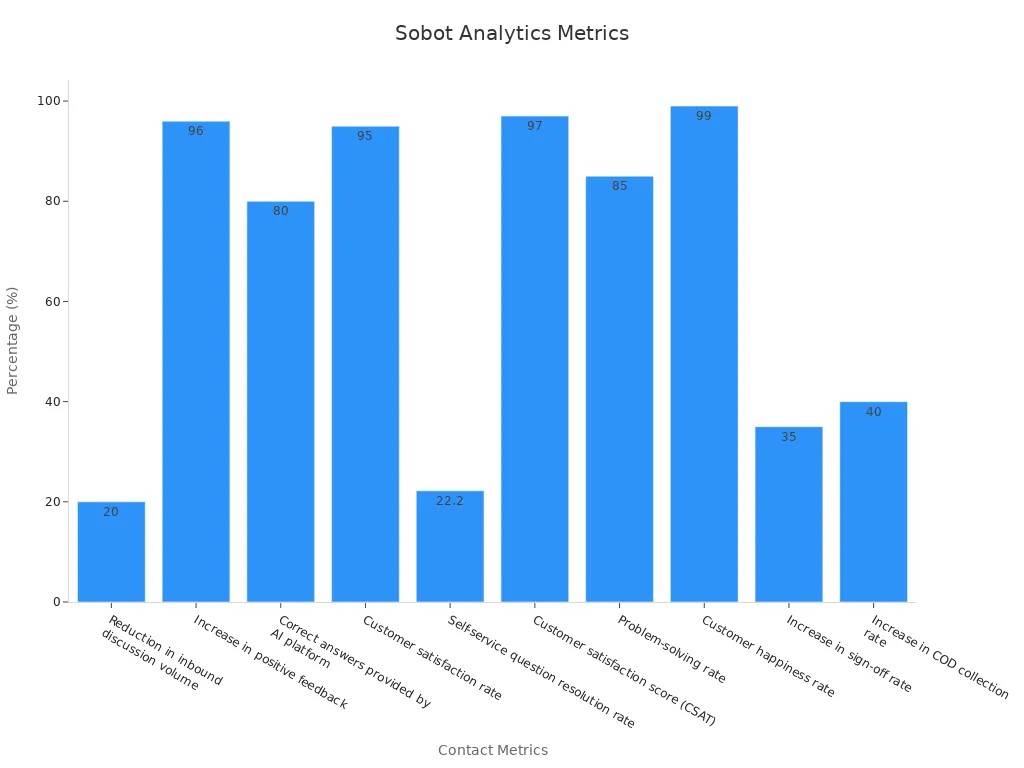
Sobot’s platform ensures you stay ahead of customer expectations. With features like live dashboards and instant reporting, you can track metrics such as call abandonment rates and customer satisfaction scores. These tools empower you to make data-driven decisions that enhance service quality.
AI-Powered Voicebot for Enhanced Customer Interactions

Sobot’s AI-powered Voicebot revolutionizes customer interactions by providing intelligent and personalized support. Available 24/7, the Voicebot handles multiple queries simultaneously, reducing wait times and improving efficiency. Studies show that 36% of consumers prefer AI chatbots for their time-saving benefits.
The Voicebot uses advanced intent recognition to deliver accurate responses, resolving 22.2% of self-service questions. It also boosts customer satisfaction rates to 95% and problem-solving rates to 85%.
| Metric Description | Value |
|---|---|
| Reduction in inbound discussion volume | 20% |
| Increase in positive feedback | 96%+ |
| Correct answers provided by AI platform | 80%+ |
| Customer satisfaction rate | 95% |
| Self-service question resolution rate | 22.2% |
| Problem-solving rate | 85% |
By integrating seamlessly with CRM systems, Sobot’s Voicebot ensures a unified view of customer interactions. This feature enhances engagement and builds trust, making your contact center a hub for exceptional service.
Seamless Integration with CRM and Other Systems
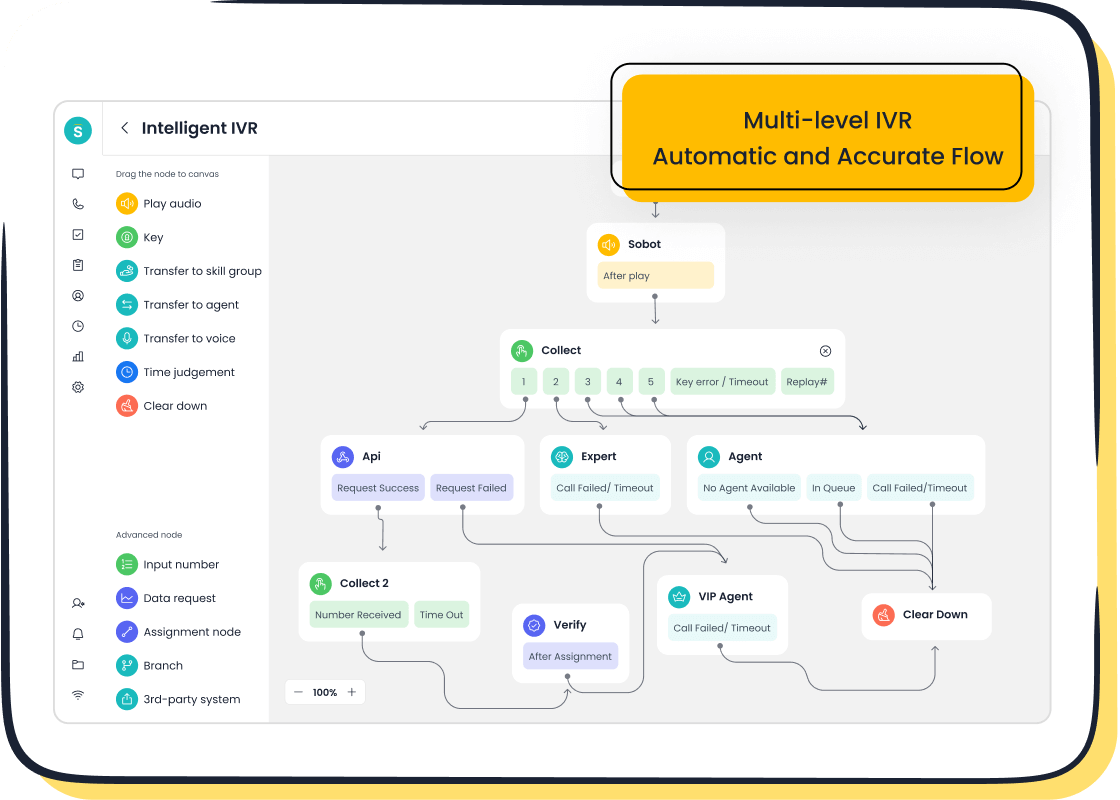
Seamless integration between your contact center and CRM systems is essential for delivering a unified customer experience. When your tools work together, you gain a complete view of customer interactions, enabling your team to provide faster and more personalized support. Without integration, data silos can form, leading to inefficiencies and missed opportunities to improve service quality.
Sobot’s Voice/Call Center simplifies this process by offering built-in integration with popular CRM platforms like Salesforce and HubSpot. This feature ensures that all customer data, from call histories to support tickets, is accessible in one place. For example, when a customer calls, your agents can instantly view their purchase history, previous inquiries, and preferences. This context allows them to resolve issues more efficiently, reducing average handle time and boosting customer satisfaction.
Did You Know?
Businesses that integrate their CRM with contact center tools report a 20% improvement in agent productivity and a 15% increase in customer retention rates.
To achieve seamless integration, follow these steps:
- Evaluate Your Current Systems: Identify the tools your team uses and ensure they support API-based connectivity.
- Choose Scalable Solutions: Opt for platforms like Sobot that offer flexible integration options to grow with your business.
- Centralize Customer Data: Store all interaction records in a unified database for easy access.
- Test and Monitor: Regularly check the integration to ensure data flows smoothly between systems.
Sobot’s platform also supports omnichannel integration, connecting voice, email, and social media interactions. This capability ensures your agents have a 360-degree view of the customer journey, empowering them to deliver exceptional service every time.
By integrating your CRM and contact center systems, you unlock the full potential of your analytics strategy. This approach not only improves operational efficiency but also enhances customer loyalty.
Implementing contact center analytics best practices transforms your ability to make data-driven decisions. By focusing on key metrics like first call resolution and customer satisfaction scores, you can uncover actionable insights that improve efficiency and service quality. High first call resolution rates lead to happier customers and lower operational costs, while strong customer satisfaction scores foster loyalty and retention.
Sobot’s Voice/Call Center equips you with advanced tools to optimize analytics capabilities. Features like real-time monitoring, intelligent IVR, and seamless CRM integration ensure your contact center operates at peak performance. By adopting these solutions, you can enhance customer experiences and drive long-term success.
FAQ
What is the best way to start using contact center analytics?
Begin by identifying key metrics like First Call Resolution (FCR) and Average Handling Time (AHT). Use tools like Sobot’s Voice/Call Center to track these metrics. Focus on small, actionable insights to improve operations. Gradually expand your analytics strategy as you gain confidence.
How can analytics improve customer satisfaction?
Analytics helps you understand customer needs and preferences. By analyzing data, you can personalize interactions, predict issues, and resolve them proactively. Tools like AI-powered Voicebots from Sobot enhance engagement by delivering quick and accurate responses, boosting satisfaction rates.
What tools should I use for contact center analytics?
Choose tools that offer real-time monitoring, predictive analytics, and seamless integration. Sobot’s Voice/Call Center provides intelligent IVR, smart call routing, and AI-powered Voicebots. These features simplify data collection and analysis, helping you make informed decisions.
How do I ensure data privacy in my contact center?
Follow data protection regulations like GDPR and CCPA. Use secure platforms like Sobot’s Voice/Call Center, which ensures encrypted data transfer. Train your team on privacy best practices and conduct regular audits to identify vulnerabilities.
Can small businesses benefit from contact center analytics?
Absolutely! Analytics helps small businesses optimize resources and improve customer experiences. Tools like Sobot’s Voice/Call Center offer cost-effective solutions with features like bulk outbound tasks and real-time monitoring. These tools make analytics accessible and impactful for businesses of all sizes.
See Also
Best 10 Analytics Tools for Call Centers This Year
Enhancing Call Center Efficiency Through Effective Monitoring
Leading 10 Speech Analysis Solutions for Call Centers
